Underwater Small Target Classification Using Sparse Multi-View Discriminant Analysis and the Invariant Scattering Transform
Abstract
1. Introduction
2. Related Work
3. Key Contributions
- Nonlinear feature extraction is performed on backscattering measurements using the invariant scattering transform. The resulting scattering coefficients are stable to noise and deformations, and they are easier to interpret than convolutional neural networks. Additionally, the wavelets used in the invariant scattering transform can effectively isolate instantaneous changes in the backscattering measurements that distinguish target classes.
- A multi-view discriminant method is used as a dimensionality reduction step to find linear combinations of the features across multiple sets of variables that increase the separation between classes in a shared lower-dimensional space.
- A sparsity penalty is added to the multi-view discriminant to select only the most informative features for classification. The iterative algorithm selects features using the sparsity-inducing norm, which is convex and does not require a brute-force combinatorial search over all subsets of features.
4. Notation
5. Materials and Methods
5.1. Data
5.2. Canonical Correlation Analysis (CCA)
5.3. Linear Discriminant Analysis (LDA)
5.4. Sparse LDA
5.5. Scattering Transform
5.6. Multi-View Discriminant Analysis (MvDA)
6. Technical Approach
- Step 1: extract a robust representation of the PondEx data using an invariant scattering convolutional network described in Section 5.5.
- Step 2: project the extracted features into a lower-dimensional space using Sparse Multi-view Discriminant Analysis.
- Step 3: train an SVM classifier on the projected features.
6.1. Step 1: Feature Extraction Using Scattering Network
6.2. Step 2: Dimensionality Reduction
6.3. Step 3: Classification
7. Results
7.1. Single-View Toy Example
7.2. Classification Accuracy on PondEx Datasets
8. Conclusions
Author Contributions
Funding
Institutional Review Board Statement
Informed Consent Statement
Data Availability Statement
Conflicts of Interest
Abbreviations
| ATR | Automatic target recognition |
| UXOs | Unexploded ordinances |
| SAS | Synthetic aperture sonar |
| ML | Machine learning |
| CNN | Convolutional neural network |
| PCA | Principal Component Analysis |
| LDA | Linear Discriminant Analysis |
| CCA | Canonical Correlation Analysis |
| MvDA | Multi-view Discriminant Analysis |
| SVM | Support vector machine |
| NN | Neural network |
Appendix A
Appendix A.1
Appendix A.2
| Algorithm A1: An efficient iterative algorithm to solve the sparsity optimization problem in Equation (32) |
Data: , Result: 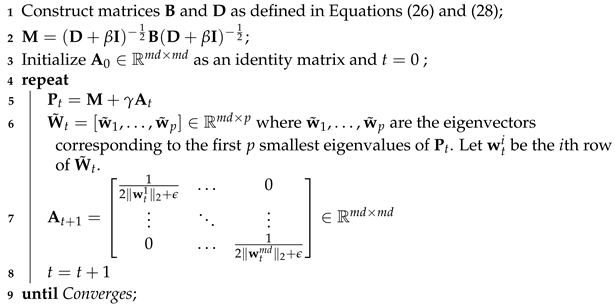 |
References
- Soules, M.E.; Broadwater, J.B. Featureless classification for active sonar systems. In Proceedings of the OCEANS’10 IEEE SYDNEY, Sydney, NSW, Australia, 24–27 May 2010; pp. 1–5. [Google Scholar]
- Hall, J.J.; Azimi-Sadjadi, M.R.; Kargl, S.G.; Zhao, Y.; Williams, K.L. Underwater unexploded ordnance (UXO) classification using a matched subspace classifier with adaptive dictionaries. IEEE J. Ocean. Eng. 2018, 44, 739–752. [Google Scholar] [CrossRef]
- Bianco, M.J.; Gerstoft, P.; Traer, J.; Ozanich, E.; Roch, M.A.; Gannot, S.; Deledalle, C.A. Machine learning in acoustics: Theory and applications. J. Acoust. Soc. Am. 2019, 146, 3590–3628. [Google Scholar] [CrossRef]
- Stack, J. Automation for underwater mine recognition: Current trends and future strategy. In Proceedings of the Detection and Sensing of Mines, Explosive Objects, and Obscured Targets XVI, Orlando, FL, USA, 25–29 April 2011; Volume 8017, pp. 205–225. [Google Scholar]
- Muller, K.E. Understanding canonical correlation through the general linear model and principal components. Am. Stat. 1982, 36, 342–354. [Google Scholar] [CrossRef]
- Hardoon, D.R.; Szedmak, S.; Shawe-Taylor, J. Canonical correlation analysis: An overview with application to learning methods. Neural Comput. 2004, 16, 2639–2664. [Google Scholar] [CrossRef] [PubMed]
- Wachowski, N.; Azimi-Sadjadi, M.R. A new synthetic aperture sonar processing method using coherence analysis. IEEE J. Ocean. Eng. 2011, 36, 665–678. [Google Scholar] [CrossRef]
- Tucker, J.D.; Azimi-Sadjadi, M.R. Coherence-based underwater target detection from multiple disparate sonar platforms. IEEE J. Ocean. Eng. 2011, 36, 37–51. [Google Scholar] [CrossRef]
- Yamada, M.; Cartmill, J.; Azimi-Sadjadi, M.R. Buried underwater target classification using the new BOSS and canonical correlation decomposition feature extraction. In Proceedings of the OCEANS 2005 MTS/IEEE, Washington, DC, USA, 17–23 September 2005; pp. 589–596. [Google Scholar]
- Pezeshki, A.; Azimi-Sadjadi, M.R.; Scharf, L.L. Undersea target classification using canonical correlation analysis. IEEE J. Ocean. Eng. 2007, 32, 948–955. [Google Scholar] [CrossRef][Green Version]
- Kubicek, B.; Sen Gupta, A.; Kirsteins, I. Canonical correlation analysis as a feature extraction method to classify active sonar targets with shallow neural networks. J. Acoust. Soc. Am. 2022, 152, 2893–2904. [Google Scholar] [CrossRef]
- Tesfaye, G.; Marchand, B.; Tucker, J.D.; Marston, T.M.; Sternlicht, D.D.; Azimi-Sadjadi, M.R. Image-based automated change detection for synthetic aperture sonar by multistage coregistration and canonical correlation analysis. IEEE J. Ocean. Eng. 2015, 41, 592–612. [Google Scholar]
- Williams, D.P.; España, A.; Kargl, S.G.; Williams, K.L. A family of algorithms for the automatic detection, isolation, and fusion of object responses in sonar data. In Proceedings of the Meetings on Acoustics, Virtual, 20–25 June 2021; Volume 44. [Google Scholar]
- Langner, F.A.; Jans, W.; Knauer, C.; Middelmann, W. Advantages and disadvantages of training based object detection/classification in SAS images. In Proceedings of the Meetings on Acoustics, Edinburgh, Scotland, 2–6 July 2012; Volume 17. [Google Scholar]
- Dobeck, G.J. Algorithm fusion for automated sea mine detection and classification. In Proceedings of the MTS/IEEE Oceans 2001. An Ocean Odyssey. Conference Proceedings (IEEE Cat. No. 01CH37295), Honolulu, HI, USA, 5–8 November 2001; Volume 1, pp. 130–134. [Google Scholar]
- Williams, D.P. Bayesian data fusion of multiview synthetic aperture sonar imagery for seabed classification. IEEE Trans. Image Process. 2009, 18, 1239–1254. [Google Scholar] [CrossRef]
- Miao, Y.; Zakharov, Y.V.; Sun, H.; Li, J.; Wang, J. Underwater acoustic signal classification based on sparse time–frequency representation and deep learning. IEEE J. Ocean. Eng. 2021, 46, 952–962. [Google Scholar] [CrossRef]
- Kan, M.; Shan, S.; Zhang, H.; Lao, S.; Chen, X. Multi-view discriminant analysis. IEEE Trans. Pattern Anal. Mach. Intell. 2015, 38, 188–194. [Google Scholar] [CrossRef] [PubMed]
- Zhu, Z.; Xu, X.; Yang, L.; Yan, H.; Peng, S.; Xu, J. A model-based sonar image atr method based on sift features. In Proceedings of the OCEANS 2014-TAIPEI, Taipei, Taiwan, 7–10 April 2014; pp. 1–4. [Google Scholar]
- Attaf, Y.; Boudraa, A.O.; Ray, C. Amplitude-based dominant component analysis for underwater mines extraction in side scans sonar. In Proceedings of the OCEANS 2016-Shanghai, Shanghai, China, 10–13 April 2016; pp. 1–4. [Google Scholar]
- Madhusudhana, S.; Gavrilov, A.; Erbe, C. Automatic detection of echolocation clicks based on a Gabor model of their waveform. J. Acoust. Soc. Am. 2015, 137, 3077–3086. [Google Scholar] [CrossRef]
- Mallat, S. A Wavelet Tour of Signal Processing; Elsevier: Amsterdam, The Netherlands, 1999. [Google Scholar]
- Gupta, A.S.; Schupp, D. Characterization of sonar target data using Gabor wavelet features. In Proceedings of the 2015 49th Asilomar Conference on Signals, Systems and Computers, Pacific Grove, CA, USA, 8–11 November 2015; pp. 1723–1726. [Google Scholar]
- Gupta, A.S.; Kirsteins, I. Disentangling sonar target features using braided feature graphs. In Proceedings of the OCEANS 2017-Anchorage, Anchorage, AK, USA, 18–21 September 2017; pp. 1–5. [Google Scholar]
- Gupta, A.S.; Kirsteins, I. Sonar signaling employing braid-encoded features on sparse gabor dictionaries. In Proceedings of the OCEANS 2019 MTS/IEEE SEATTLE, Seattle, WA, USA, 27–31 October 2019; pp. 1–4. [Google Scholar]
- Kubicek, B.; Sen Gupta, A.; Kirsteins, I. Sonar target representation using two-dimensional Gabor wavelet features. J. Acoust. Soc. Am. 2020, 148, 2061–2072. [Google Scholar] [CrossRef]
- Shang, W.; Sohn, K.; Almeida, D.; Lee, H. Understanding and improving convolutional neural networks via concatenated rectified linear units. In Proceedings of the International Conference on Machine Learning, PMLR, New York City, NY, USA, 19–24 June 2016; pp. 2217–2225. [Google Scholar]
- Bruna, J.; Mallat, S. Invariant scattering convolution networks. IEEE Trans. Pattern Anal. Mach. Intell. 2013, 35, 1872–1886. [Google Scholar] [CrossRef]
- Wang, H.; Li, S.; Zhou, Y.; Chen, S. SAR automatic target recognition using a Roto-translational invariant wavelet-scattering convolution network. Remote Sens. 2018, 10, 501. [Google Scholar] [CrossRef]
- Williams, D.P. Underwater target classification in synthetic aperture sonar imagery using deep convolutional neural networks. In Proceedings of the 2016 23rd International Conference on Pattern Recognition (ICPR), Cancun, Mexico, 4–8 December 2016; pp. 2497–2502. [Google Scholar]
- Wang, X.; Jiao, J.; Yin, J.; Zhao, W.; Han, X.; Sun, B. Underwater sonar image classification using adaptive weights convolutional neural network. Appl. Acoust. 2019, 146, 145–154. [Google Scholar] [CrossRef]
- Yang, T.; Wang, X.; Liu, Z. Ship type recognition based on ship navigating trajectory and convolutional neural network. J. Mar. Sci. Eng. 2022, 10, 84. [Google Scholar] [CrossRef]
- Jin, A.; Zeng, X. A novel deep learning method for underwater target recognition based on res-dense convolutional neural network with attention mechanism. J. Mar. Sci. Eng. 2023, 11, 69. [Google Scholar] [CrossRef]
- Wang, H.; Zhou, Q.; Wei, S.; Xue, X.; Zhou, X.; Zhang, X. Research on seabed sediment classification based on the MSC-transformer and sub-bottom profiler. J. Mar. Sci. Eng. 2023, 11, 1074. [Google Scholar] [CrossRef]
- Liu, D.; Yang, H.; Hou, W.; Wang, B. A Novel Underwater Acoustic Target Recognition Method Based on MFCC and RACNN. Sensors 2024, 24, 273. [Google Scholar] [CrossRef] [PubMed]
- Zhao, J.; Zhang, H. Seabed classification based on sofm neural network. In Proceedings of the 2008 International Conference on Computer Science and Software Engineering, Wuhan, China, 12–14 December 2008; Volume 4, pp. 902–905. [Google Scholar]
- Valdenegro-Toro, M. End-to-end object detection and recognition in forward-looking sonar images with convolutional neural networks. In Proceedings of the 2016 IEEE/OES Autonomous Underwater Vehicles (AUV), Tokyo, Japan, 6–9 November 2016; pp. 144–150. [Google Scholar]
- Nguyen, H.T.; Lee, E.H.; Lee, S. Study on the classification performance of underwater sonar image classification based on convolutional neural networks for detecting a submerged human body. Sensors 2019, 20, 94. [Google Scholar] [CrossRef]
- Williams, D.P.; Dugelay, S. Multi-view SAS image classification using deep learning. In Proceedings of the OCEANS 2016 MTS/IEEE Monterey, Monterey, CA, USA, 19–23 September 2016; pp. 1–9. [Google Scholar]
- Williams, D.P. On the use of tiny convolutional neural networks for human-expert-level classification performance in sonar imagery. IEEE J. Ocean. Eng. 2020, 46, 236–260. [Google Scholar] [CrossRef]
- Paraschiv, M.; Padrino, R.; Casari, P.; Bigal, E.; Scheinin, A.; Tchernov, D.; Fernández Anta, A. Classification of underwater fish images and videos via very small convolutional neural networks. J. Mar. Sci. Eng. 2022, 10, 736. [Google Scholar] [CrossRef]
- McKay, J.; Gerg, I.; Monga, V.; Raj, R.G. What’s mine is yours: Pretrained CNNs for limited training sonar ATR. In Proceedings of the OCEANS 2017-Anchorage, Anchorage, AK, USA, 18–21 September 2017; pp. 1–7. [Google Scholar]
- Jin, L.; Liang, H.; Yang, C. Accurate underwater ATR in forward-looking sonar imagery using deep convolutional neural networks. IEEE Access 2019, 7, 125522–125531. [Google Scholar] [CrossRef]
- Simonyan, K.; Zisserman, A. Very deep convolutional networks for large-scale image recognition. arXiv 2014, arXiv:1409.1556. [Google Scholar]
- Szegedy, C.; Liu, W.; Jia, Y.; Sermanet, P.; Reed, S.; Anguelov, D.; Erhan, D.; Vanhoucke, V.; Rabinovich, A. Going deeper with convolutions. In Proceedings of the IEEE Conference on Computer Vision and Pattern Recognition, Boston, MA, USA, 7–12 June 2015; pp. 1–9. [Google Scholar]
- Le, H.T.; Phung, S.L.; Chapple, P.B.; Bouzerdoum, A.; Ritz, C.H. Deep gabor neural network for automatic detection of mine-like objects in sonar imagery. IEEE Access 2020, 8, 94126–94139. [Google Scholar]
- Mallat, S. Understanding deep convolutional networks. Philos. Trans. R. Soc. A Math. Phys. Eng. Sci. 2016, 374, 20150203. [Google Scholar] [CrossRef]
- Domingos, P. A few useful things to know about machine learning. Commun. ACM 2012, 55, 78–87. [Google Scholar] [CrossRef]
- Roweis, S.T.; Saul, L.K. Nonlinear dimensionality reduction by locally linear embedding. Science 2000, 290, 2323–2326. [Google Scholar] [CrossRef]
- Fei, T.; Kraus, D.; Berkel, P. A new idea on feature selection and its application to the underwater object recognition. In Proceedings of the Meetings on Acoustics, Edinburgh, Scotland, 2–6 July 2012; Volume 17. [Google Scholar]
- Hotelling, H. Analysis of a complex of statistical variables into principal components. J. Educ. Psychol. 1933, 24, 417. [Google Scholar] [CrossRef]
- Schölkopf, B.; Smola, A.; Müller, K.R. Kernel principal component analysis. In Proceedings of the International Conference on Artificial Neural Networks, Lausanne, Switzerland, 8–10 October 1997; pp. 583–588. [Google Scholar]
- Linhardt, T.J.; Sen Gupta, A.; Bays, M. Convolutional Autoencoding of Small Targets in the Littoral Sonar Acoustic Backscattering Domain. J. Mar. Sci. Eng. 2022, 11, 21. [Google Scholar] [CrossRef]
- Tibshirani, R. Regression shrinkage and selection via the lasso. J. R. Stat. Soc. Ser. Stat. Methodol. 1996, 58, 267–288. [Google Scholar] [CrossRef]
- Nie, F.; Huang, H.; Cai, X.; Ding, C. Efficient and robust feature selection via joint L2, 1-norms minimization. Adv. Neural Inf. Process. Syst. 2010, 23, 1813–1821. [Google Scholar]
- Ding, C.; Zhou, D.; He, X.; Zha, H. R 1-pca: Rotational invariant l 1-norm principal component analysis for robust subspace factorization. In Proceedings of the 23rd International Conference on Machine Learning, Pittsburgh, PA, USA, 25–29 June 2006; pp. 281–288. [Google Scholar]
- Yang, Y.; Shen, H.T.; Ma, Z.; Huang, Z.; Zhou, X. L2,1-norm regularized discriminative feature selection for unsupervised learning. In Proceedings of the IJCAI International Joint Conference on Artificial Intelligence, Barcelona, Catalonia, Spain, 16–22 July 2011. [Google Scholar]
- Tesei, A.; Maguer, A.; Fox, W.; Lim, R.; Schmidt, H. Measurements and modeling of acoustic scattering from partially and completely buried spherical shells. J. Acoust. Soc. Am. 2002, 112, 1817–1830. [Google Scholar] [CrossRef]
- Sammelmann, G.S.; Trivett, D.H.; Hackman, R.H. The acoustic scattering by a submerged, spherical shell. I: The bifurcation of the dispersion curve for the spherical antisymmetric Lamb wave. J. Acoust. Soc. Am. 1989, 85, 114–124. [Google Scholar] [CrossRef]
- Magand, F.; Chevret, P. Time frequency analysis of energy distribution for circumferential waves on cylindrical elastic shells. Acta Acust. United Acust. 1996, 82, 707–716. [Google Scholar]
- Kargl, S.; Williams, K. Full scale measurement and modeling of the acoustic response of proud and buried munitions at frequencies from 1–30 khz. In Final Report, SERDP Project MR-1665; University of Washington: Seattle, WA, USA, 2012; pp. 18–19. [Google Scholar]
- Theodoridis, S. Machine Learning: A Bayesian and Optimization Perspective; Academic Press: Cambridge, MA, USA, 2015. [Google Scholar]
- Bishop, C.M.; Nasrabadi, N.M. Pattern Recognition and Machine Learning; Springer: Berlin/Heidelberg, Germany, 2006; Volume 4. [Google Scholar]
- Wang, H.; Yan, S.; Xu, D.; Tang, X.; Huang, T. Trace ratio vs. ratio trace for dimensionality reduction. In Proceedings of the 2007 IEEE Conference on Computer Vision and Pattern Recognition, Minneapolis, MN, USA, 17–22 June 2007; pp. 1–8. [Google Scholar]
- Andén, J.; Mallat, S. Deep scattering spectrum. IEEE Trans. Signal Process. 2014, 62, 4114–4128. [Google Scholar] [CrossRef]
- Andreux, M.; Angles, T.; Exarchakis, G.; Leonarduzzi, R.; Rochette, G.; Thiry, L.; Zarka, J.; Mallat, S.; Andén, J.; Belilovsky, E.; et al. Kymatio: Scattering transforms in python. J. Mach. Learn. Res. 2020, 21, 1–6. [Google Scholar]
- Pedregosa, F.; Varoquaux, G.; Gramfort, A.; Michel, V.; Thirion, B.; Grisel, O.; Blondel, M.; Prettenhofer, P.; Weiss, R.; Dubourg, V.; et al. Scikit-learn: Machine learning in Python. J. Mach. Learn. Res. 2011, 12, 2825–2830. [Google Scholar]
- Schölkopf, B.; Smola, A.J. Learning with Kernels: Support Vector Machines, Regularization, Optimization, and Beyond; MIT Press: Cambridge, MA, USA, 2002. [Google Scholar]
- Williams, K.L.; Kargl, S.G.; Thorsos, E.I.; Burnett, D.S.; Lopes, J.L.; Zampolli, M.; Marston, P.L. Acoustic scattering from a solid aluminum cylinder in contact with a sand sediment: Measurements, modeling, and interpretation. J. Acoust. Soc. Am. 2010, 127, 3356–3371. [Google Scholar] [CrossRef] [PubMed]
- Kargl, S.G.; Espana, A.L.; Williams, K.L.; Kennedy, J.L.; Lopes, J.L. Scattering from objects at a water–sediment interface: Experiment, high-speed and high-fidelity models, and physical insight. IEEE J. Ocean. Eng. 2014, 40, 632–642. [Google Scholar] [CrossRef]
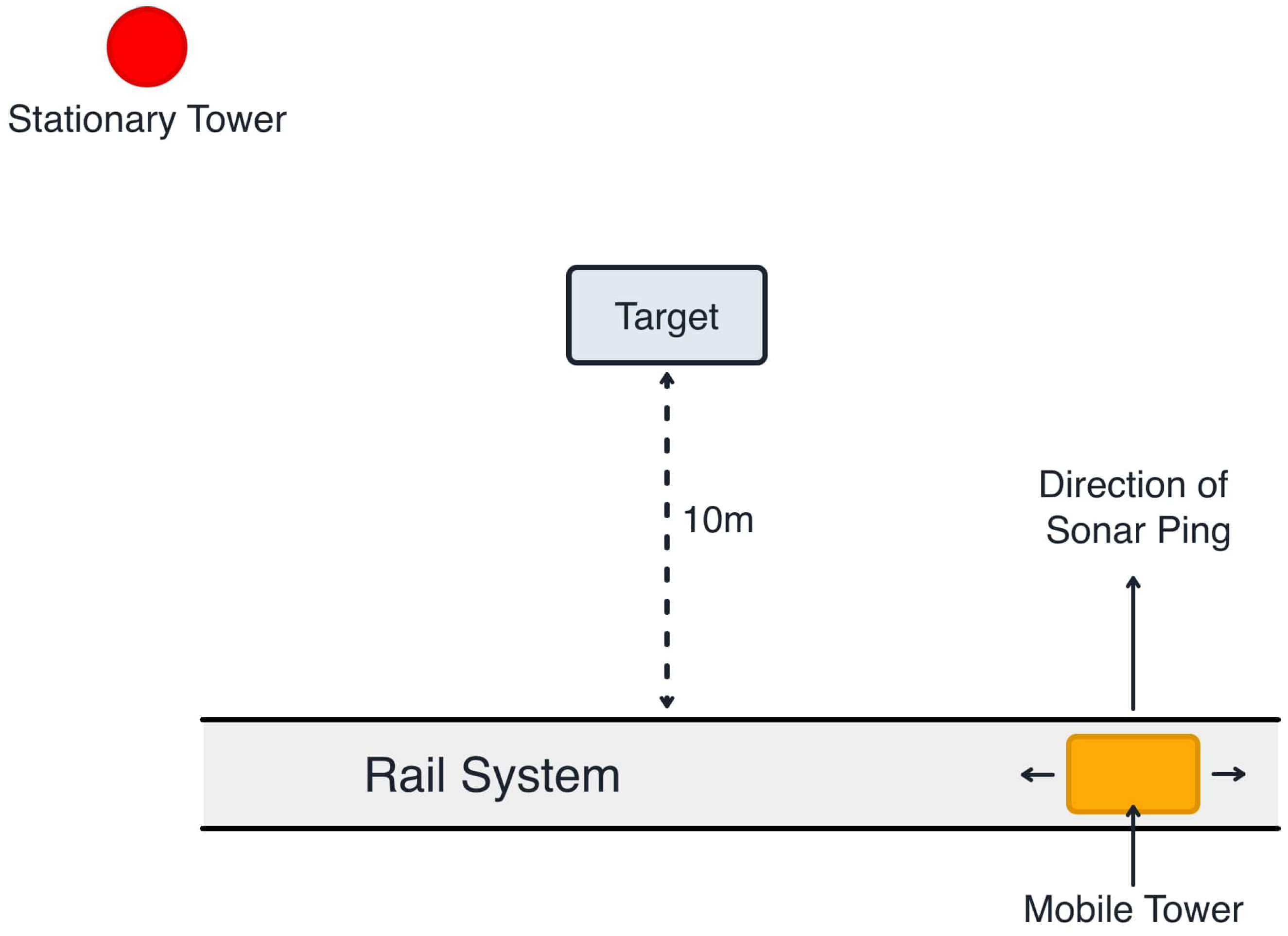
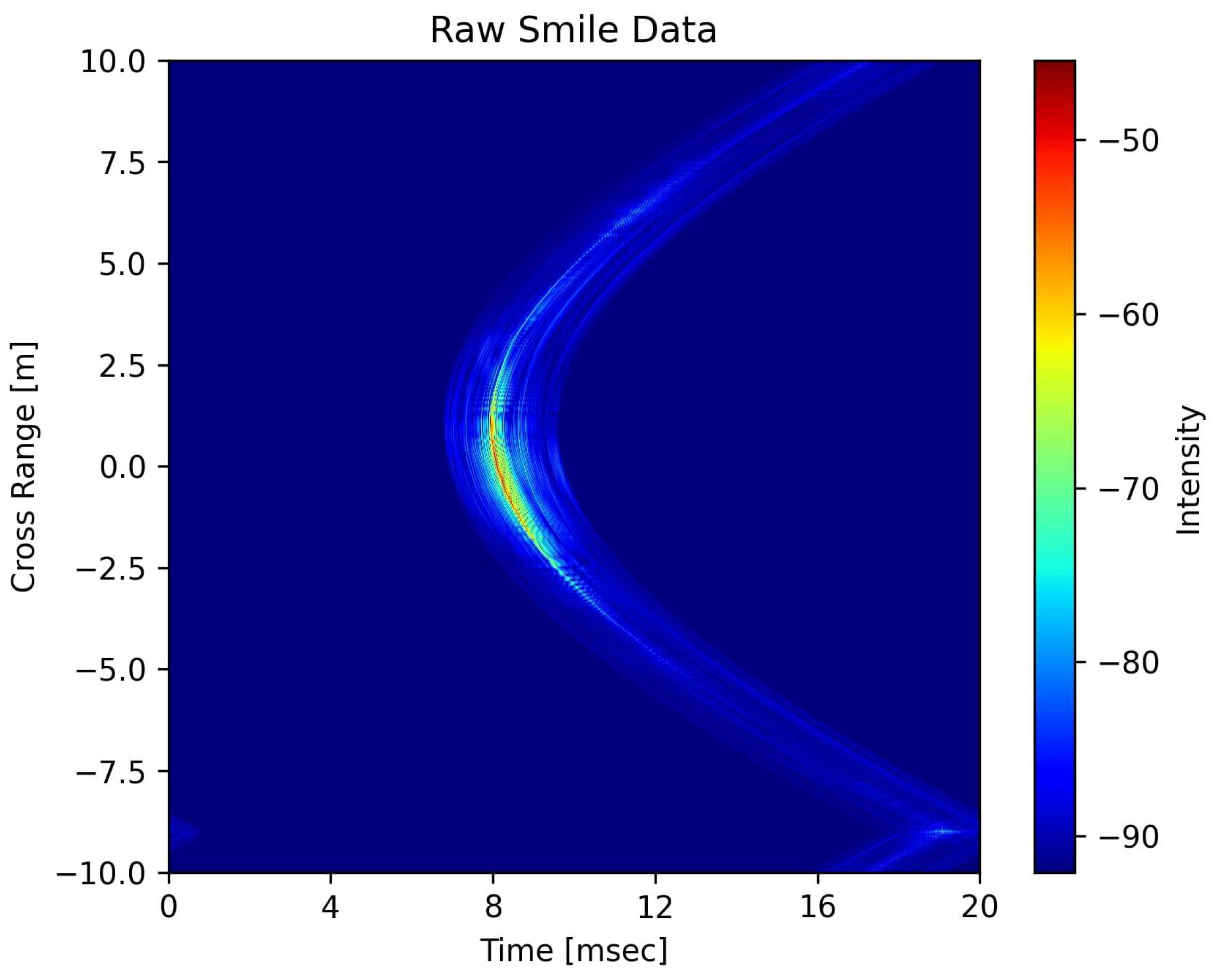
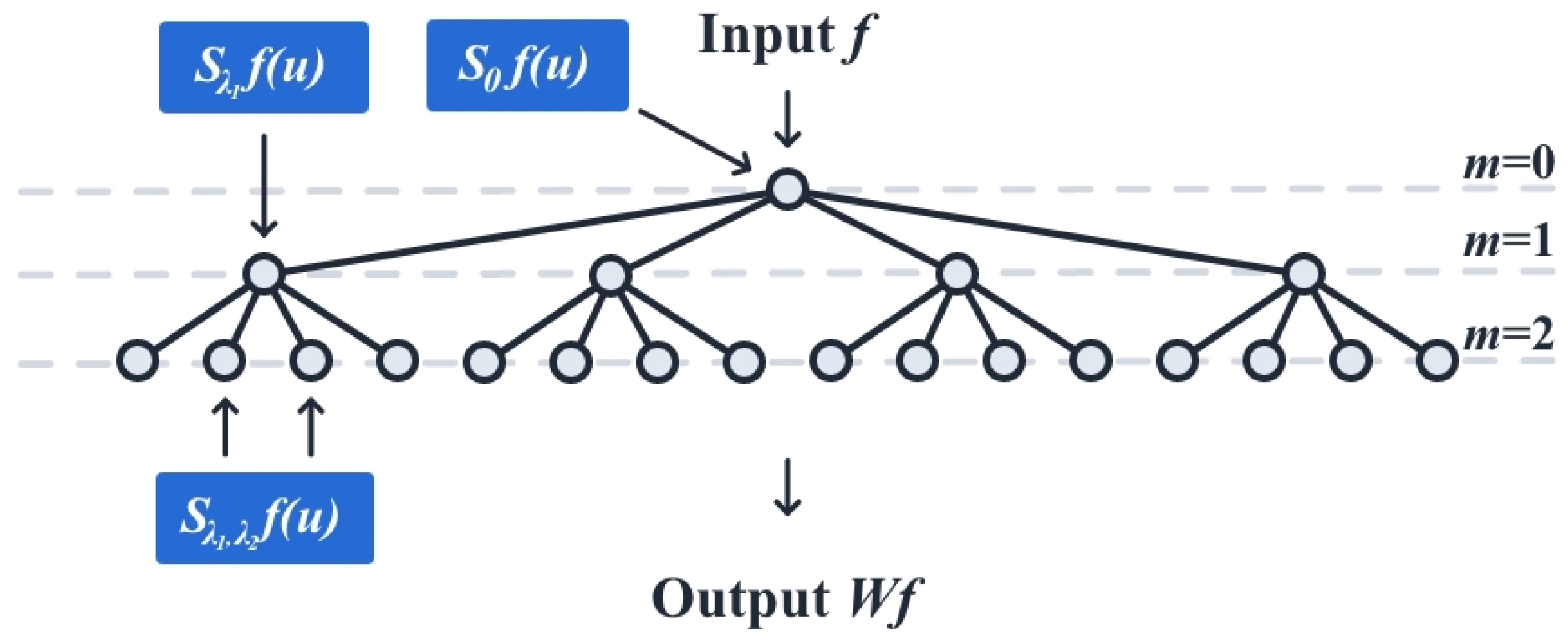
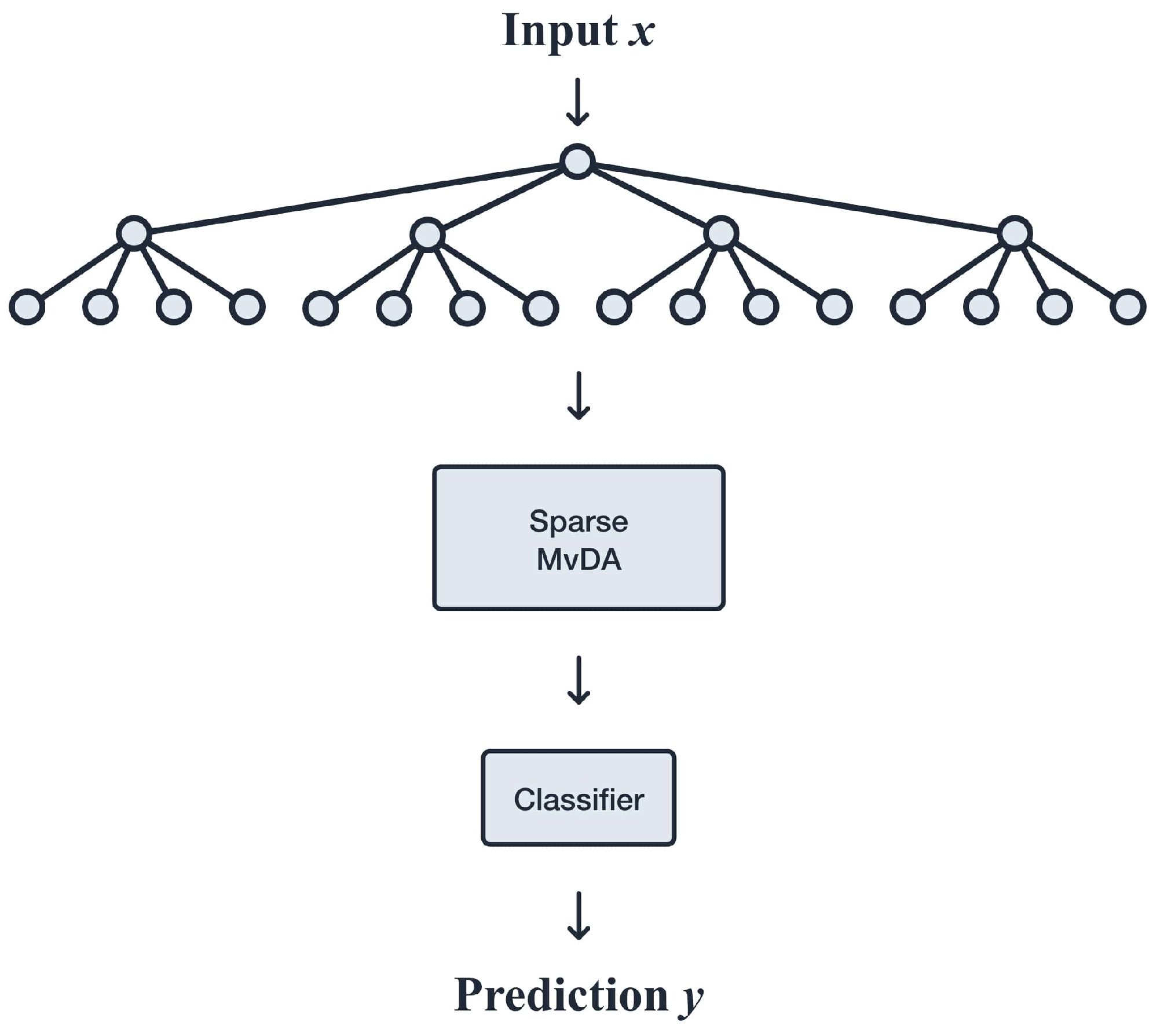
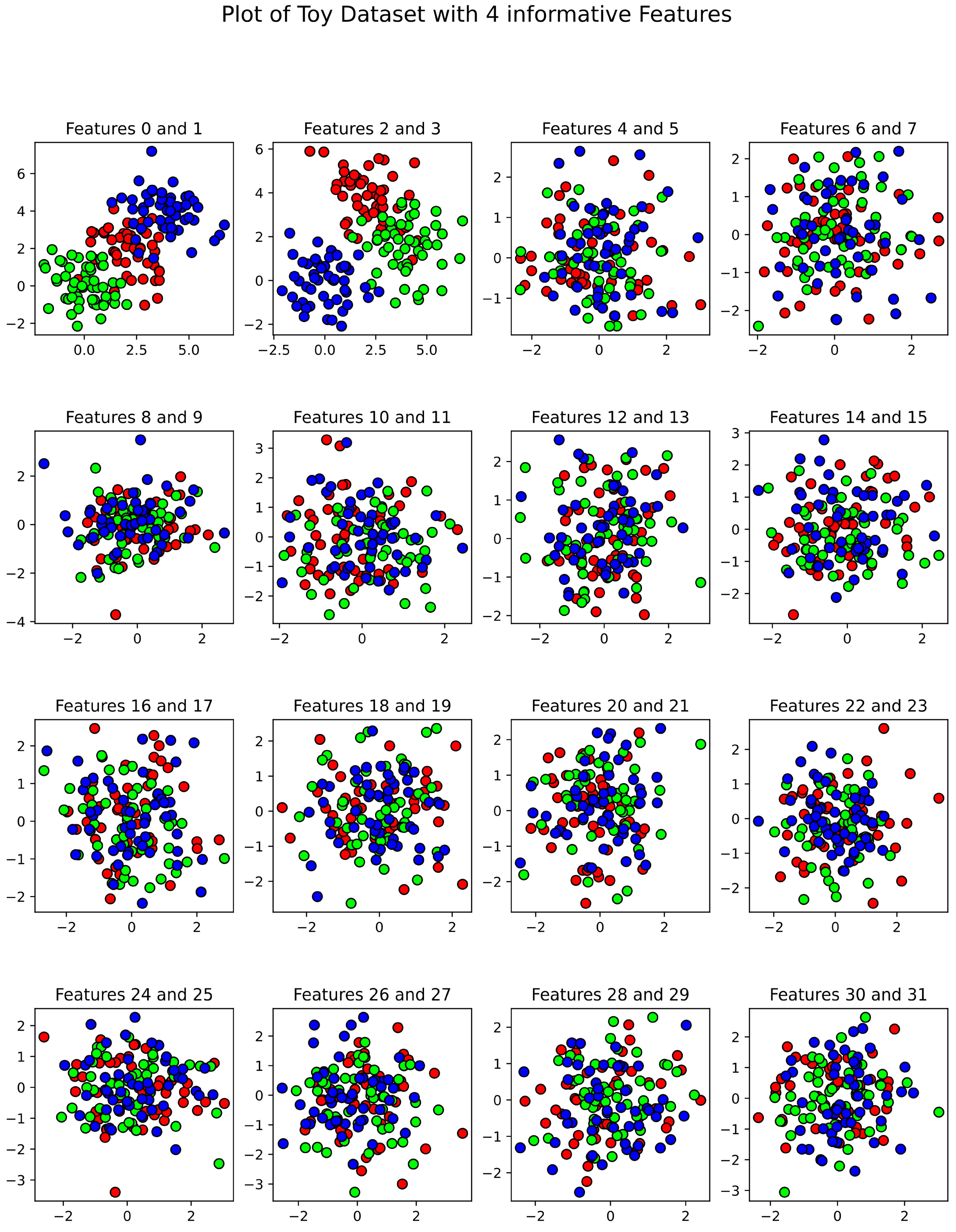

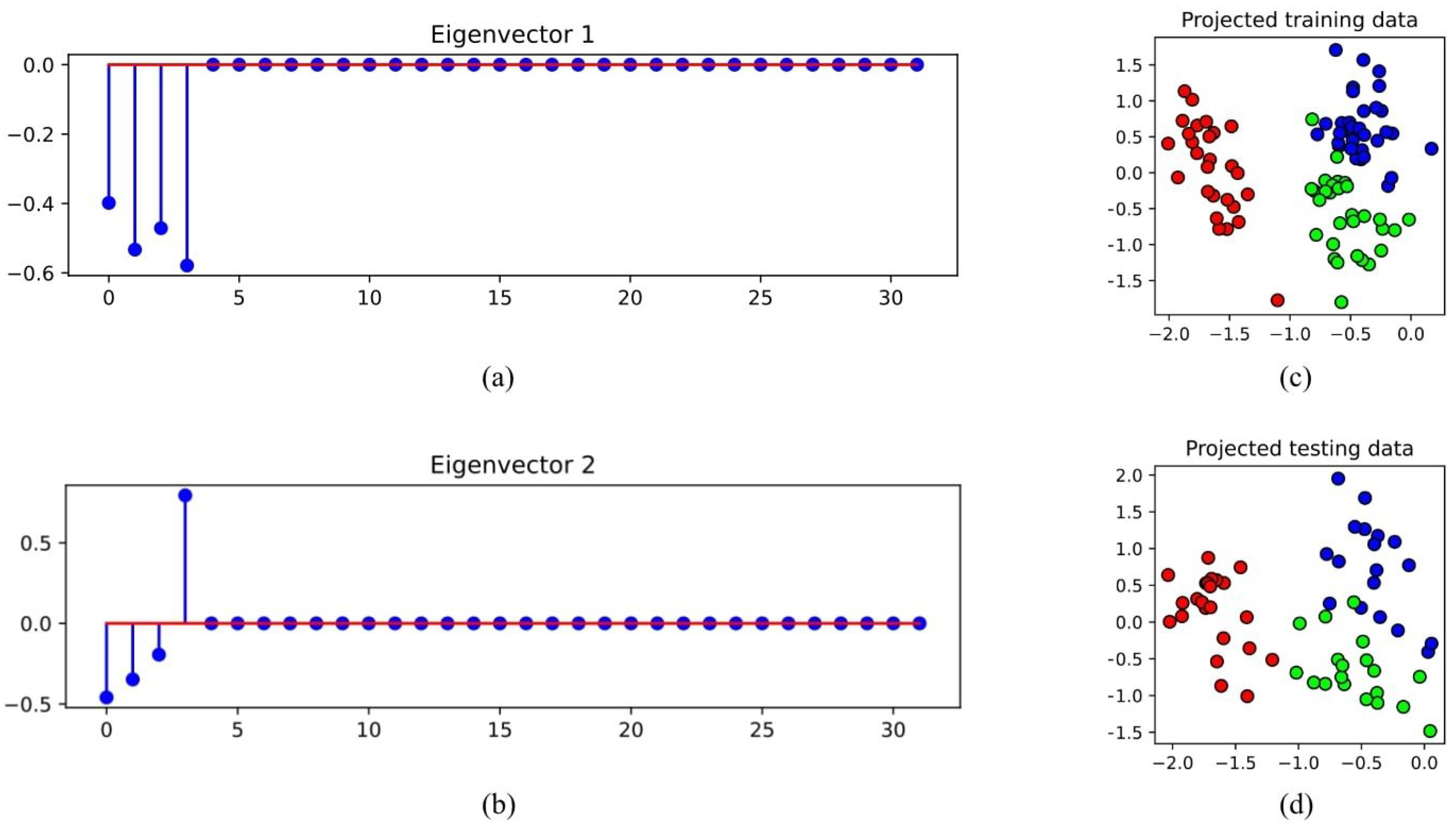
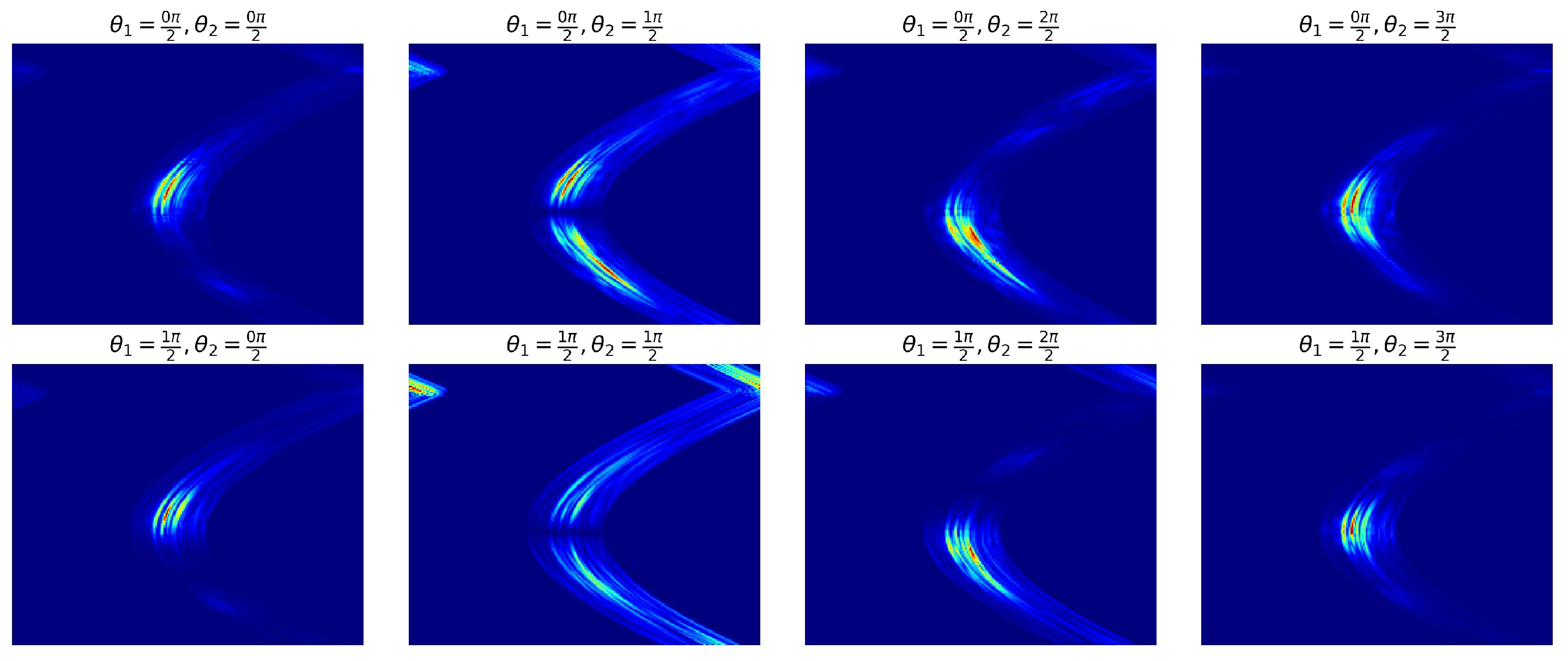
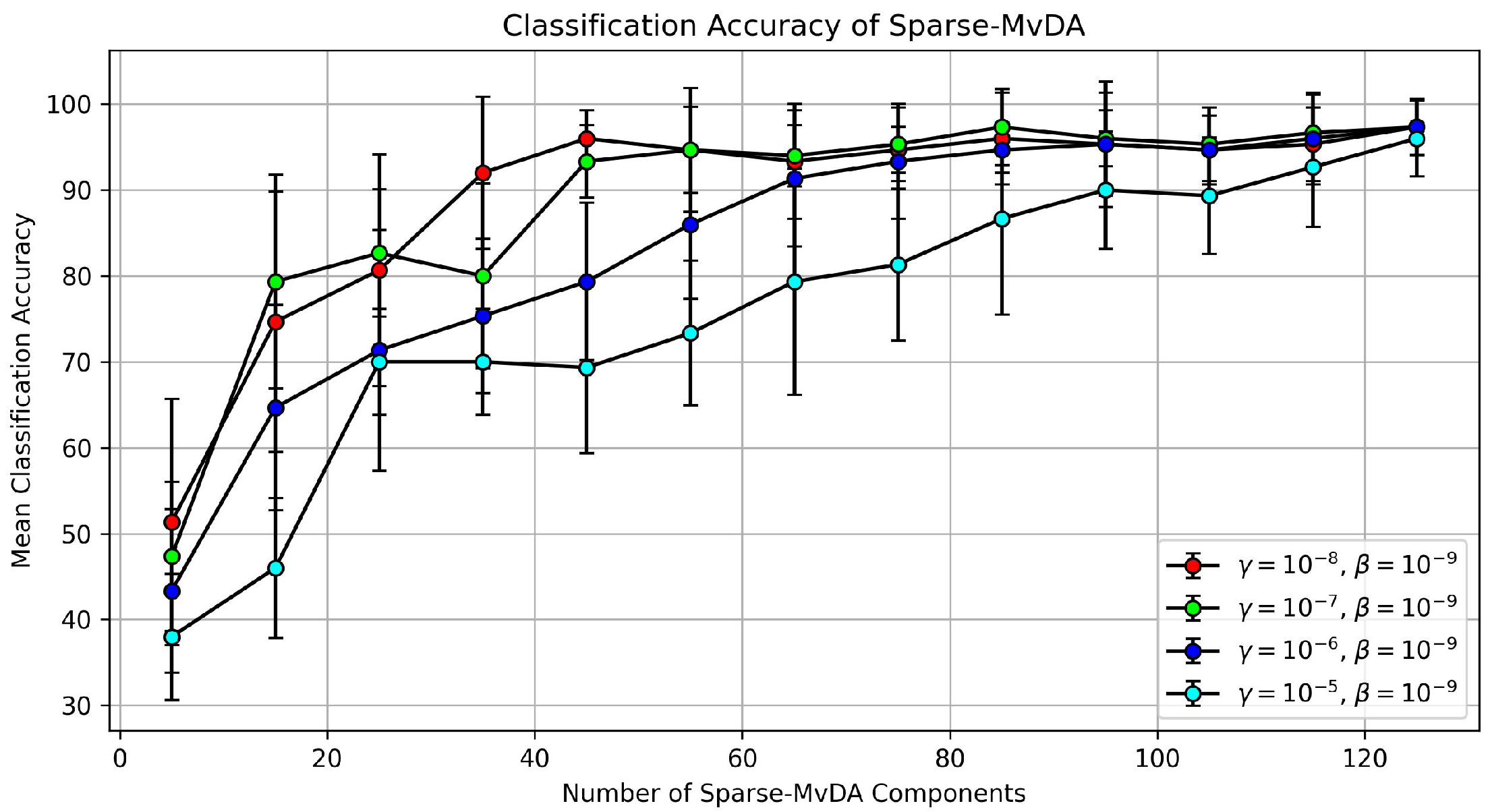
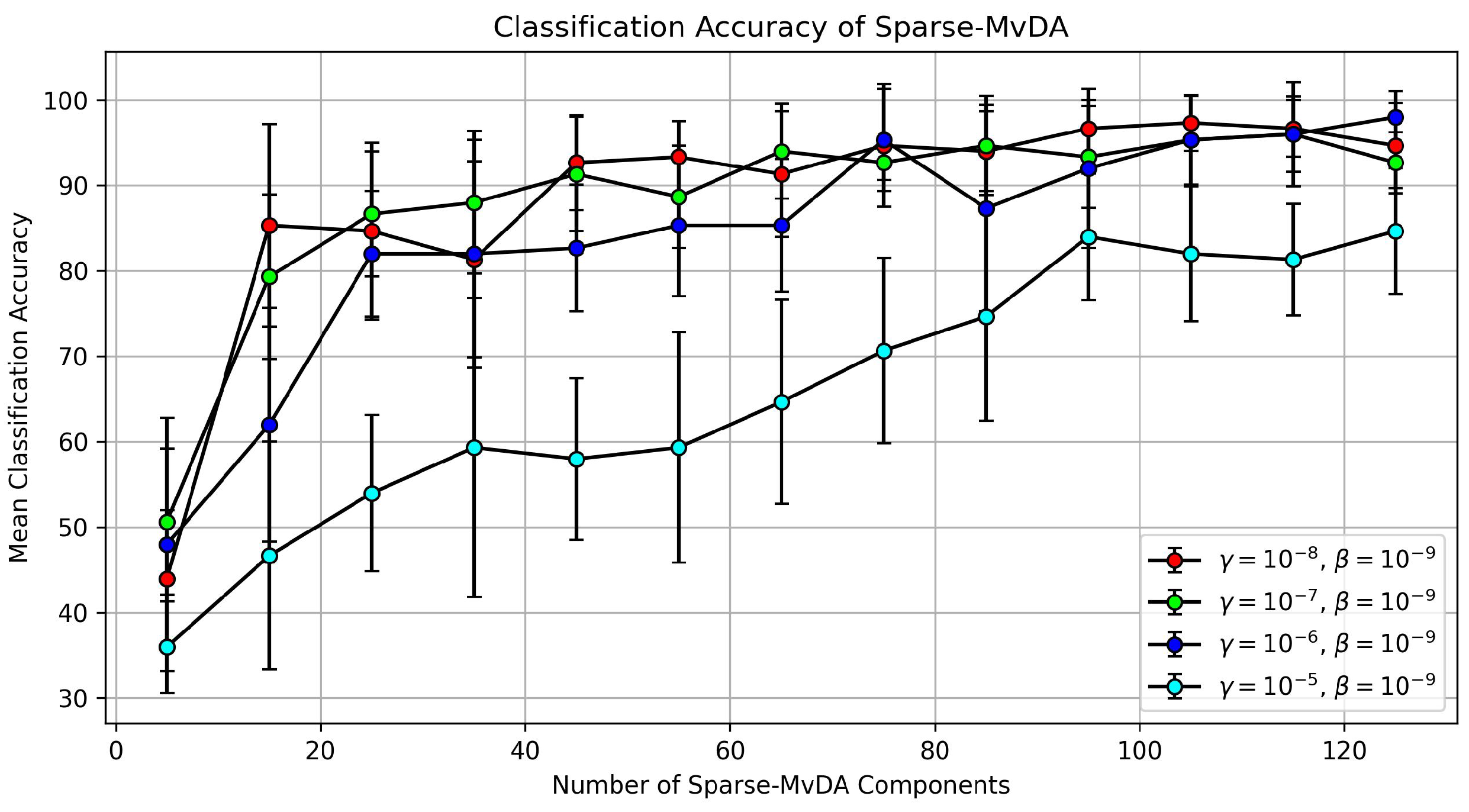
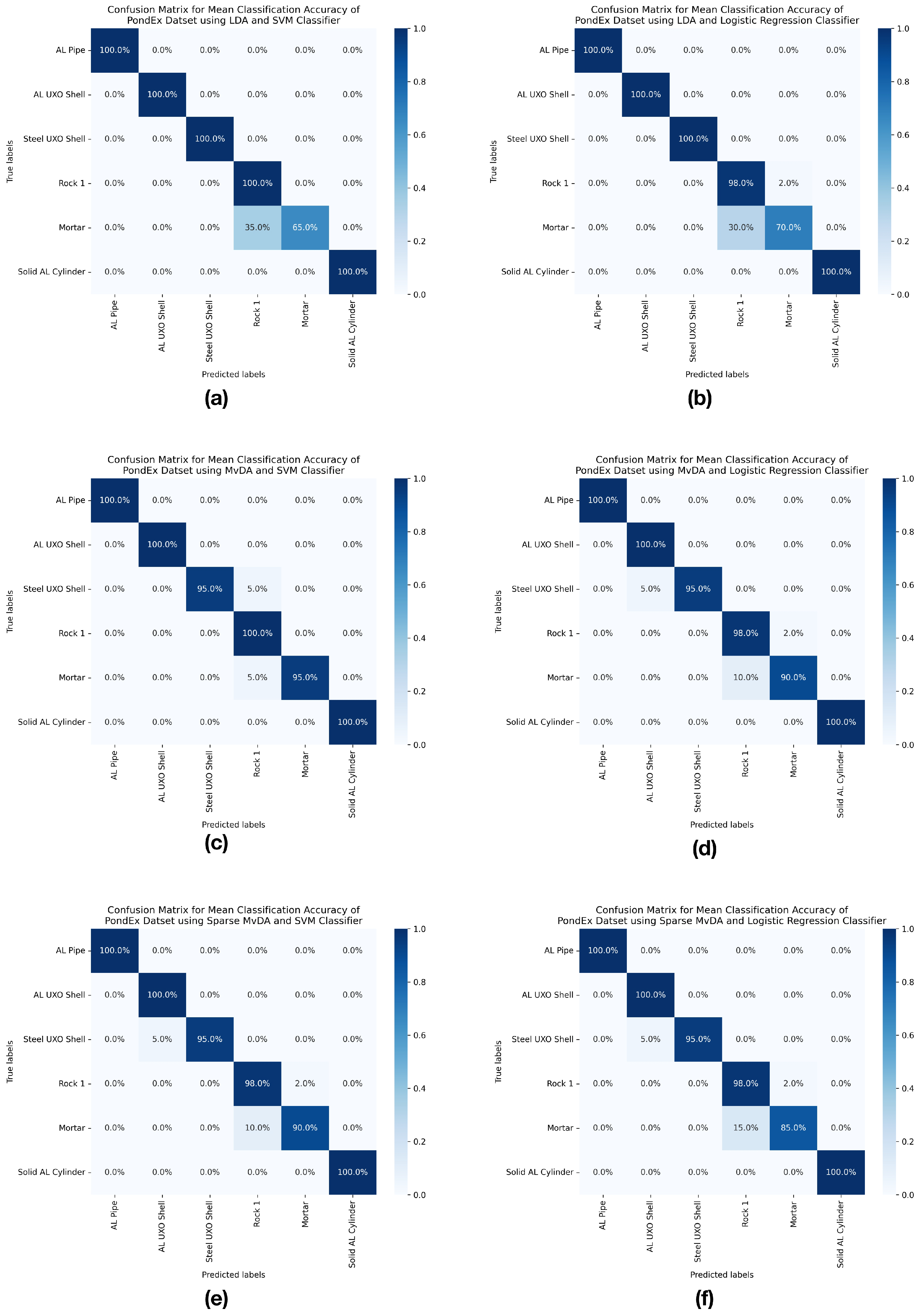
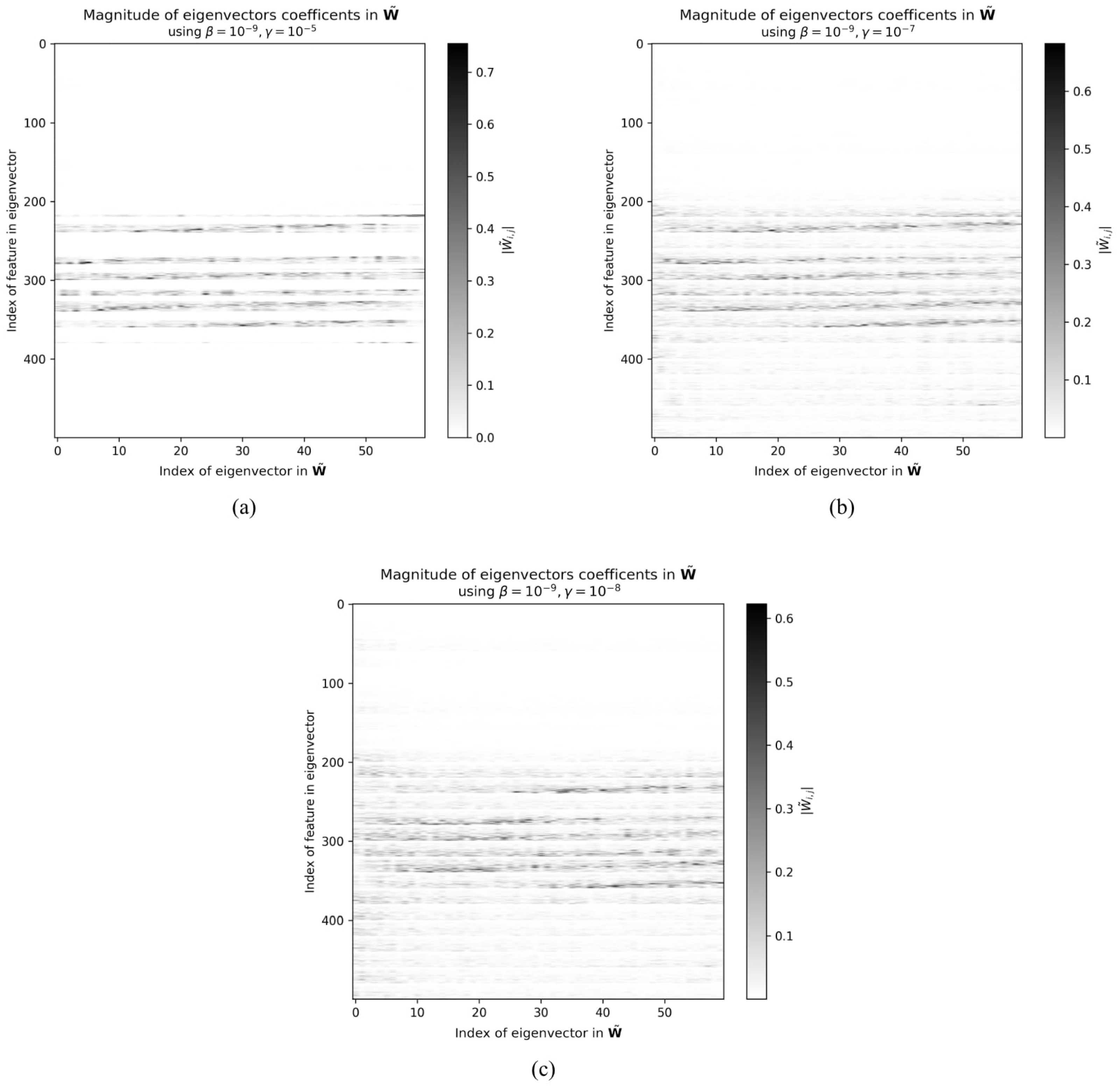

| Target Shell | Number of Samples |
|---|---|
| Aluminum Pipe | 9 |
| Aluminum UXO Shell | 9 |
| Steel UXO Shell | 9 |
| Rock #1 | 27 |
| Mortar | 9 |
| Solid Aluminum Cylinder | 9 |
| Dimensionality Reduction | Accuracy |
|---|---|
| PCA | |
| MvDA | |
| Sparse MvDA |
| Input Data | Dimensionality Reduction | Accuracy |
|---|---|---|
| PCA | ||
| Acoustic Color | MvDA | |
| Sparse MvDA | ||
| PCA | ||
| Scattering Coefficients | MvDA | |
| Sparse MvDA |
| Classifier | Dimensionality Reduction | Accuracy |
|---|---|---|
| LDA | ||
| Logistic Regression | MvDA | |
| Sparse MvDA | ||
| LDA | ||
| Support Vector Machine | MvDA | |
| Sparse MvDA |
Disclaimer/Publisher’s Note: The statements, opinions and data contained in all publications are solely those of the individual author(s) and contributor(s) and not of MDPI and/or the editor(s). MDPI and/or the editor(s) disclaim responsibility for any injury to people or property resulting from any ideas, methods, instructions or products referred to in the content. |
© 2024 by the authors. Licensee MDPI, Basel, Switzerland. This article is an open access article distributed under the terms and conditions of the Creative Commons Attribution (CC BY) license (https://creativecommons.org/licenses/by/4.0/).
Share and Cite
Christensen, A.; Sen Gupta, A.; Kirsteins, I. Underwater Small Target Classification Using Sparse Multi-View Discriminant Analysis and the Invariant Scattering Transform. J. Mar. Sci. Eng. 2024, 12, 1886. https://doi.org/10.3390/jmse12101886
Christensen A, Sen Gupta A, Kirsteins I. Underwater Small Target Classification Using Sparse Multi-View Discriminant Analysis and the Invariant Scattering Transform. Journal of Marine Science and Engineering. 2024; 12(10):1886. https://doi.org/10.3390/jmse12101886
Chicago/Turabian StyleChristensen, Andrew, Ananya Sen Gupta, and Ivars Kirsteins. 2024. "Underwater Small Target Classification Using Sparse Multi-View Discriminant Analysis and the Invariant Scattering Transform" Journal of Marine Science and Engineering 12, no. 10: 1886. https://doi.org/10.3390/jmse12101886
APA StyleChristensen, A., Sen Gupta, A., & Kirsteins, I. (2024). Underwater Small Target Classification Using Sparse Multi-View Discriminant Analysis and the Invariant Scattering Transform. Journal of Marine Science and Engineering, 12(10), 1886. https://doi.org/10.3390/jmse12101886






